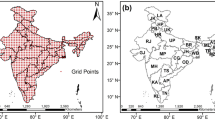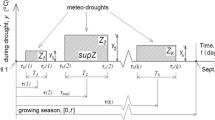Abstract
With their severe environmental and socioeconomic impact, drought events belong to the most far-reaching natural disasters. Effects are tremendous in rain-fed agricultural areas as in Africa. We analyzed and modeled the spatio-temporal statistical behavior of the Normalized Difference Vegetation Index as a risk indicator for drought, reflecting its stochastic effects on vegetation. The study used a data set for Rwanda obtained from multitemporal satellite remote sensor measurements during a 14-year period and divided into season-specific spatial random fields. Maximal deviations from average conditions were modeled with max-stable Brown–Resnick processes taking methodological and computational challenges into account. Those challenges are caused by the large spatial extent and the relatively short time span covered by the data. Extensive simulations enabled us to go beyond the observations and, thus, to estimate several important characteristics of extreme drought events, such as their expected return period.











Similar content being viewed by others
References
Bajgiran PR, Darvishsefat AA, Khalili A, Makhdoum MF (2008) Using AVHRR-based vegetation indices for drought monitoring in the northwest of Iran. J Arid Environ 72(6):1086–1096
Bevilacqua M, Gaetan C, Mateu J, Porcu E (2012) Estimating space and space-time covariance functions for large data sets: a weighted composite likelihood approach. J Am Stat Assoc 107(497):268–280
Blanchet J, Davison AC (2011) Spatial modeling of extreme snow depth. Ann Appl Stat 5(3):1699–1725
Brown BM, Resnick SI (1977) Extreme values of independent stochastic processes. J Appl Probab 14(4):732–739
Chilès JP, Delfiner P (2012) Geostatistics. Modeling spatial uncertainty, 2nd edn. Wiley, Hoboken, NJ
Coles SG (1993) Regional modelling of extreme storms via max-stable processes. J R Stat Soc Ser B 55(4):797–816
Coles SG, Tawn JA (1996) Modelling extremes of the areal rainfall process. J R Stat Soc Ser B 58(2):329–347
Conover WJ (1980) Practical nonparametric statistics. Wiley, New York
Davenport M, Nicholson S (1993) On the relation between rainfall and the normalized difference vegetation index for diverse vegetation types in East Africa. Int J Remote Sens 14(12):2369–2389
Davison AC, Padoan SA, Ribatet M (2012) Statistical modeling of spatial extremes. Stat Sci 27(2):161–186. doi:10.1214/11-STS376
de Haan L (1984) A spectral representation for max-stable processes. Ann Probab 12(4):1194–1204
Dieker AB, Mikosch T (2015) Exact simulation of Brown–Resnick random fields at a finite number of locations. Extremes 18(2):301–314
Dombry C, Engelke S, Oesting M (2016) Exact simulation of max-stable processes. Biometrika 103(2):303–317
Farr TG, Rosen PA, Caro E, Crippen R, Duren R, Hensley S, Kobrick M, Paller M, Rodriguez E, Roth L, Seal D, Shaffer S, Shimada J, Umland J, Werner M, Oskin M, Burbank D, Alsdor D (2007) The shuttle radar topography mission. Rev Geophys 45(2):RG2004
Fawcett L, Walshaw D (2016) Sea-surge and wind speed extremes: optimal estimation strategies for planners and engineers. Stoch Environ Res Risk Assess 30(2):463–480
Feng J, Yan D, Li C, Gao Y, Liu J (2014) Regional frequency analysis of extreme precipitation after drought events in the Heihe River Basin, northwest China. J Hydrol Eng 19(6):1101–1112
Friedl MA, Sulla-Menashe D, Tan B, Schneider A, Ramankutty N, Sibley A, Huang X (2010) MODIS collection 5 global land cover: algorithm refinements and characterization of new datasets. Remote Sens Environ 114(1):168–182
Gaume J, Eckert N, Chambon G, Naaim M, Bel L (2013) Mapping extreme snowfalls in the French Alps using max-stable processes. Water Resour Res 49(2):1079–1098
Genton MG, Ma Y, Sang H (2011) On the likelihood function of Gaussian max-stable processes. Biometrika 98(2):481–488
Gumma MK, Thenkabail PS, Maunahan A, Islam S, Nelson A (2014) Mapping seasonal rice cropland extent and area in the high cropping intensity environment of Bangladesh using MODIS 500m data for the year 2010. ISPRS J Photogramm Remote Sens 91:98–113
Gumma MK, Mohanty S, Nelson A, Arnel R, Mohammed IA, Das SR (2015) Remote sensing based change analysis of rice environments in Odisha, India. J Environ Manag 148:31–41
Hong X, Guo S, Zhou Y, Xiong L (2015) Uncertainties in assessing hydrological drought using streamflow drought index for the upper Yangtze River basin. Stoch Environ Res Risk Assess 29(4):1235–1247
Jahanbaksh Asl S, Khorshiddoust AM, Dinpashoh Y, Sarafrouzeh F (2013) Frequency analysis of climate extreme events in Zanjan, Iran. Stoch Environ Res Risk Assess 27(7):1637–1650
Kabluchko Z (2011) Extremes of independent Gaussian processes. Extremes 14(3):285–310
Kabluchko Z, Schlather M, de Haan L (2009) Stationary max-stable fields associated to negative definite functions. Ann Probab 37(5):2042–2065
Katz RW, Parlange MB, Naveau P (2002) Statistics of extremes in hydrology. Adv Water Resour 25(812):1287–1304
Kogan FN (1987) Vegetation index for areal analysis of crop conditions. In: Proceedings of the 18th conference on agricultural and forest meteorology, AMS W. Lafayette, pp 103–106
Kogan FN (1990) Remote sensing of weather impacts on vegetation in non-homogeneous areas. Int J Remote Sens 11(8):1405–1419
Leadbetter MR, Lindgren G, Rootzén H (1983) Extremes and related properties of random sequences and processes. Springer series in statistics. Springer, Berlin
Lin ML, Chu CM, Tsai BW (2011) Drought risk assessment in western Inner-Mongolia. Int J Environ Res 5(1):139–148
Marcon G, Padoan SA, Naveau P, Muliere P (2014) Multivariate nonparametric estimation of the Pickands dependence function using Bernstein polynomials. arXiv: 1405.5228
Millard SP (2013) EnvStats: an R package for environmental statistics. Springer, New York
Naveau P, Guillou A, Cooley D, Diebolt J (2009) Modelling pairwise dependence of maxima in space. Biometrika 96(1):1–17
Nelsen RB (2006) An introduction to copulas. Springer, Berlin
Nicholson SE (1996) A review of climate dynamics and climate variability in eastern Africa. The Limnology, Climatology and Paleoclimatology of the East African Lakes, Gordon and Breach, Amsterdam
Oesting M, Kabluchko Z, Schlather M (2012) Simulation of Brown–Resnick processes. Extremes 15:89–107
Oesting M, Ribatet M, Dombry C (2016a) Simulation of max-stable processes. In: Dey DK, Yan J (eds) Extreme value modeling and risk analysis. Chapman and Hall/CRC, Boca Raton, pp 195–214
Oesting M, Schlather M, Friederichs P (2016b) Statistical post-processing of forecasts for extremes using bivariate brown–resnick processes with an application to wind gusts. Extremes. doi:10.1007/s10687-016-0277-x
Opitz T (2013) Extremal t processes: elliptical domain of attraction and a spectral representation. J Multivar Anal 122:409–413
Opitz T (2016) Modeling asymptotically independent spatial extremes based on Laplace random fields. Spat Stat 16:1–18
Padoan SA, Ribatet M, Sisson SA (2010) Likelihood-based inference for max-stable processes. J Am Stat Assoc 105(489):263–277
Peters AJ, Walter-Shea EA, Ji L, Vina A, Hayes M, Svoboda MD (2002) Drought monitoring with NDVI-based standardized vegetation index. Photogramm Eng Rem Sens 68(1):71–75
Resnick SI (2008) Extreme values, regular variation and point processes. Springer, New York
Ribatet M (2013) Spatial extremes: max-stable processes at work. J Soc Fr Stat 154(2):156–177
Rouse JW, Haas RH, Schell JA, Deering DW (1973) Monitoring vegetation systems in the Great Plains with ERTS. In: Third ERTS symposium, NASA SP-351, vol I. NASA, Washington, DC, pp 309–317
Rulinda CM, Bijker W, Stein A (2010) Image mining for drought monitoring in eastern Africa using Meteosat SEVIRI data. Int J Appl Earth Obs Geoinf 12:S63–S68
Rulinda CM, Dilo A, Bijker W, Stein A (2012) Characterising and quantifying vegetative drought in east Africa using fuzzy modelling and NDVI data. J Arid Environ 78:169–178
Rulinda CM, Stein A, Turdukulov UD (2013) Visualizing and quantifying the movement of vegetative drought using remote-sensing data and GIS. Int J Geogr Inf Sci 27(8):1481–1496
Savo V, De Zuliani E, Salvati L, Perini L, Caneva G (2012) Long-term changes in precipitation and temperature patterns and their possible impacts on vegetation (Tolfa-Cerite area, central Italy). Appl Ecol Env Res 10(3):243–266
Schlather M (2002) Models for stationary max-stable random fields. Extremes 5(1):33–44
Schlather M, Tawn JA (2003) A dependence measure for multivariate and spatial extreme values: properties and inference. Biometrika 90(1):139–156
Silva AT, Naghettini M, Portela MM (2016) On some aspects of peaks-over-threshold modeling of floods under nonstationarity using climate covariates. Stoch Env Res Risk Assess 30(1):207–224
Smith RL (1990) Max–stable processes and spatial extremes. Unpublished manuscript
Solano R, Didan K, Jacobson A, Huete A (2010) MODIS vegetation index user’s guide (MOD13 series). The University of Arizona, Tucson
Song X, Saito G, Kodama M, Sawada H (2004) Early detection system of drought in east Asia using NDVI from NOAA/AVHRR data. Int J Remote Sens 25(16):3105–3111
Thibaud E, Mutzner R, Davison AC (2013) Threshold modeling of extreme spatial rainfall. Water Resour Res 49(8):4633–4644
Thibaud E, Aalto J, Cooley DS, Davison AC, Heikkinen J (2016) Bayesian inference for the Brown-Resnick process, with an application to extreme low temperatures. Ann Appl Stat 10(4):2303–2324
Tucker CJ (1979) Red and photographic infrared linear combinations for monitoring vegetation. Remote Sens Environ 8(2):127–150
Wadsworth JL, Tawn JA (2012) Dependence modelling for spatial extremes. Biometrika 99(2):253–272
Wadsworth JL, Tawn JA, Jonathan P (2010) Accounting for choice of measurement scale in extreme value modeling. Ann Appl Stat 4(3):1558–1578
Ward JH Jr (1963) Hierarchical grouping to optimize an objective function. J Am Stat Assoc 58(301):236–244
Wi S, Valdés JB, Steinschneider S, Kim TW (2016) Non-stationary frequency analysis of extreme precipitation in South Korea using peaks-over-threshold and annual maxima. Stoch Env Res Risk Assess 30(2):583–606
Zhang Q, Xiao M, Singh VP, Chen X (2013) Copula-based risk evaluation of hydrological droughts in the East River basin, China. Stoch Env Res Risk Assess 27(6):1397–1406
Acknowledgements
This work was mainly undertaken while M. Oesting was at ITC, University of Twente, The Netherlands. The authors are grateful to Professor Michael L. Stein and two anonymous referees for valuable comments and suggestions.
Author information
Authors and Affiliations
Corresponding author
Appendix: Bivariate density of Brown–Resnick processes
Appendix: Bivariate density of Brown–Resnick processes
Analogously to Genton et al. (2011), the bivariate density \(f_{\zeta (x_1;S),\zeta (x_2;S)}(\cdot ,\cdot ; \vartheta _\gamma (S))\) for the random vector \((\zeta (x_1;S),\zeta (x_2;S))\), \(x_1,x_2 \in {\mathscr {X}}\), is given by
where \({\varPhi }\) and \(\varphi\) denote the cumulative distribution function and the probability density function of the standard normal distribution, respectively. In order to calculate the bivariate density \(f_{Z(x_1;S),Z(x_2;S)}(\cdot ; \theta (S))\) for the vector of temporal maxima \((Z(x_1;S),Z(x_2;S))\) of transformed NDVI values, we apply the density transformation formula to (30) and obtain
where \(\vartheta (S) = (\vartheta _{GEV}(S), \vartheta _{\gamma }(S))^\top\).
Rights and permissions
About this article
Cite this article
Oesting, M., Stein, A. Spatial modeling of drought events using max-stable processes. Stoch Environ Res Risk Assess 32, 63–81 (2018). https://doi.org/10.1007/s00477-017-1406-z
Published:
Issue Date:
DOI: https://doi.org/10.1007/s00477-017-1406-z




